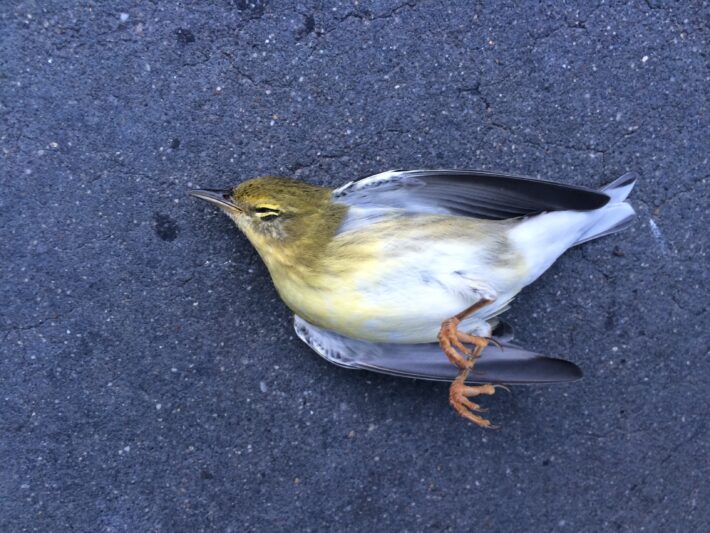
It’s migration season, which means millions of birds are flying through New York City as they make their way along the Atlantic Flyway, the route known to bird enthusiasts as the path between South and Central America to breeding grounds near the Arctic Circle. This month, however, more birds in the skies above New York City may also mean more birds on the ground.
Between 90,000 and 230,000 migratory birds die from colliding with buildings in New York City each year, according to nonprofit NYC Audubon, which has been working to conserve birds and their city habitats for over 40 years. The group blames the large number of deaths on birds running into buildings because they can’t see glass or are disoriented by artificial light.
“Buildings located near parks can experience more collisions,” said Catherine Quayle, social media director at rehabilitation and education center, Wild Bird Fund. She explained that in Midtown, collisions are common near buildings that are less than 100 feet tall because that’s about the height of nearby trees.
“I haven’t found one alive this season yet,” said Alex Israel, a volunteer with NYC Audubon while surveying the area near the Time Warner Center in Columbus Circle. Israel is part of the group’s Project Safe Flight, which enlists volunteers to monitor bird deaths citywide.
The group uses data from dBird, an online database that gathers bird collision information from public reports to recognize areas of concern.
Midtown’s Jacob K. Javits Convention Center, an 185 foot tall, all-glass building was once among these problematic locations. The building on West 34th Street and 11th Avenue underwent a major renovation in 2013 to combat the issue. The construction project marked the first time a major city building was fitted with bird-friendly glass, according to NYC Audubon. The project is believed to have reduced the number of birds colliding with the building by over 90%.
“When we talk about bird-friendly glass people think about patterns or distracting elements on the glass, whereas at the Javits Center, nobody even notices it on the glass and it’s a beautiful space,” said Dan Piselli, director of sustainability at architectural firm FXCollaborative, which spearheaded the project.
But the collision problem persists in other parts of the city. dBird data shows 2,135 dead or injured birds were reported in New York City this year, compared to 1,872 in 2020.
Volunteers from Project Safe Flight began surveying Times Square in September after reports of multiple bird collisions. But officials from NYC Audubon said the area presents unique challenges.
“Buildings on the Times Square route have balconies so if birds hit a window higher than the first few floors, they wouldn’t land on the ground nor would they be visible from the ground level,” said Katherine Chen, community science & outreach manager with the group. She said so far this year, a large number of dead birds have not been found in the area but that doesn’t necessarily mean collisions haven’t been happening there.
Nearly 500 injured or dead birds have been taken to the Wild Bird Fund this migration season. “They come from all over the city but disproportionately from downtown and Midtown Manhattan,” said Quayle.
“This loss is partially what’s affecting bird populations across the globe and in the last 50 years, we’ve lost about 30% of the world’s bird population,” said Dustin Partridge, director of conservation and science at NYC Audubon. “They are seed dispersers, they do pest control, they’re food for other species, and an essential component in a thriving global ecosystem and as we’re losing them that’s going to have big consequences,” he said.
In an attempt to mitigate the problem, the city’s Department of Buildings passed a law in 2020 requiring all newly constructed buildings and major retrofit construction projects beginning in January 2021 or later use bird-friendly design.
“This is a required item, that must be met in order for the project to be approved,” said DOB Press Secretary Andrew Rudansky. “During the application review process for a construction project that is subject to the law, a DOB plan examiner will check to ensure that bird-friendly glass is indicated on the construction drawings.”
In addition, the city council passed legislation last year requiring all nonessential outdoor lights be turned off between the hours of 11 p.m. and 6 a.m. on all city-owned and city-leased buildings during peak migration season. The law does not apply to privately-owned buildings.
“Putting a film on windows that make the glass visible to birds and turning off lights at night, are two small changes that can really help global bird populations,” said Partridge.